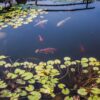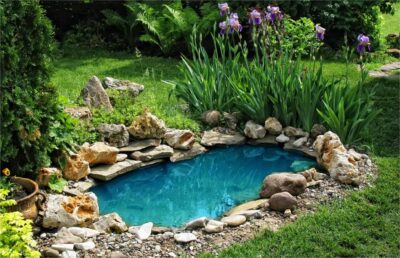Let’s talk about cleaning your pond.
Ponds are great for a lot of things: they can be a place to relax, to get away from the city and enjoy nature (and they’re also pretty good at growing food). But they can also be quite gross if you don’t clean them regularly.
We’ve talked before about how important it is to get rid of all that sludge and muck that builds up in your pond, but what’s the easiest way to do it?
What does sludge in a pond look like?
Sludge is a general term for any thick, viscous fluid composed of various organic and/or inorganic matter. In ponds, sludge refers to the accumulation of dead leaves and other materials that have settled at the bottom of your pond.
It can also refer to decomposing algae, which are green but turn brown when they die. While sludge may look bad, it can actually be beneficial because it helps stabilize your pond ecosystem by providing nutrients for plant growth and aeration for aquatic life.
Sludge in a pond can be caused by a number of different things, including:
- Decomposing algae
- Excessive fish feeding
- Poor filtration
- Inadequate aeration
Types Of Sludge:
Sludge is a common problem in ponds and water features. There are many different causes of sludge, and the first step towards resolving it is to determine what type of sludge you have. Here are some of the common types:
Organic Sludge – This type of sludge is usually caused by decaying plant matter, either from plants that you have added to your pond or by pond algae. It can also be caused by dead fish or other animals in your pond.
This type of sludge often has an unpleasant odor, but it is not toxic or dangerous for humans or pets. You can remove this type of sludge with an algae eater or by adding beneficial bacteria to your pond water.
Black Slime Sludge – Black slime is not harmful, but it can make your pond look unsightly. This type of sludge forms when there is too much phosphate in your water, which encourages algal growth in your pond.
If you notice black slime on top of the water in your pond, try lowering the amount of phosphates in your water using phosphate binders.
Should I remove the sludge from my pond?
If your pond is sludgy, you may be tempted to remove it. But this can be very difficult and dangerous.
First, you need to know how deep the sludge is. You may need to get a diver in to clear the bottom of your pond, or at least give you an idea of how deep it is.
If the sludge is less than 2 feet deep, you may be able to lift it out with a net or by hand. If it’s deeper than that, you’ll probably need to hire someone with a skimmer for this job – unless you want to risk getting stuck in the muck yourself!
If the sludge has been building up in your pond for some time, there could be dead plants and animals under it that could release harmful toxins when disturbed.
So make sure that any contractor doing this job knows what they’re doing and doesn’t disturb any organic material while they’re working on cleaning out your pond.*
How do you siphon sludge out of a pond?
There are a few different ways to siphon sludge out of a pond. You can use a siphon hose, or you may be able to use your garden hose. If you have an electric pump, you can use that as well.
If you have a large amount of water in your pond and want to get rid of it quickly, the best way is to use an electric pump. This will allow you to pump more water at once, and also helps if your pond has fish in it. If there are fish in the pond, they may get sucked into the vacuum created by the pump and be killed or injured if not handled properly.
You can also use a siphon hose or a garden hose for smaller amounts of water. This is good for getting rid of smaller clumps or bits of sludge that are floating around in the water rather than having them settle on the bottom where they can build up over time.
Does anything eat pond sludge?
Pond sludge is a mixture of organic matter, nutrients and water that accumulates in ponds. It’s created when dead algae and other aquatic plants sink to the bottom of the pond and decompose. Pond sludge is also known as pond scum, pond scum compost or algae compost.
Pond sludge can be used as fertilizer or compost in gardens or landscaping projects. It’s rich in nitrogen, phosphorus and potassium — the major elements found in fertilizers that promote plant growth. Because it contains so many nutrients, it can also be applied directly to lawns to encourage grass growth.
When handling pond sludge, wear gloves and protective clothing so you don’t come into contact with its bacteria.
How do you treat a pond muck?
Treating a pond muck is something that you should do before adding new fish to your pond. Pond muck is a greenish-brown color, and it’s usually found on the bottom of your pond. The treatment for pond muck will depend on the severity of the problem.
If you have a small amount of muck, then you can use an algae scraper or net to remove it. However, if you have a large amount of muck, then it’s best to treat it with chemicals or mechanical means.
Treating with Chemicals
Treating with chemicals is one way to treat a pond muck problem. There are several different types of chemicals that are used to treat this problem:
Algaecides: These are used when there are algae blooms in ponds; however, these won’t kill bacteria or other organisms that may be causing the muck buildup.
Muck removers: These contain enzymes and bacteria that help break down organic matter in ponds; however, these won’t kill algae blooms either.
Contact insecticides: These are insecticides that kill insects such as mosquitoes; however, they aren’t effective against larger animals like fish and frogs.
Mechanical Removal
Mechanical removal involves taking a net or rake and physically removing the muck from the bottom of your pond. This is effective if you have a small amount of muck but not very efficient if there is a large amount of it.
The best time to clean a pond is in the springtime. The water will be warm enough to get into the pond and you can also start adding some of your plants back into the pond.
If you have a large amount of muck, you may want to hire someone to come in and clean it up for you. If it’s just a small amount then here are some steps:
- First – make sure you have everything out of the pond that can be removed. This includes fish, plants and anything else that is biodegradable (such as leaves). You can then use a net to scoop up the muck on top of the water and remove it from the pond. You may need more than one scooping session depending on how much there is.
- Then – use a skimmer net with an attachment that allows it to go down below the surface of the water. This allows you to pull out any remaining debris that may be hidden within the muck.
- After this – if there are still some areas where there is still muck present, then use a garden hose with a spray nozzle attached to direct water towards those areas until they are cleaned up.









